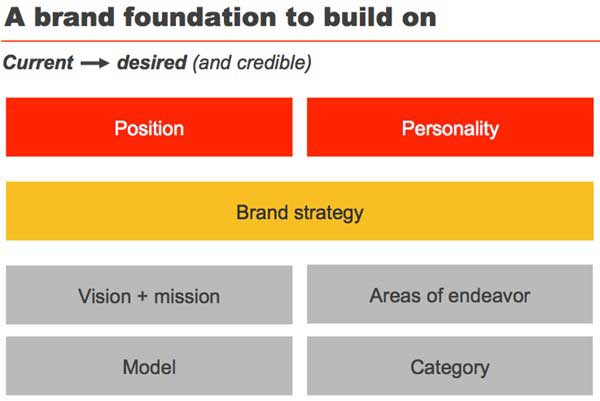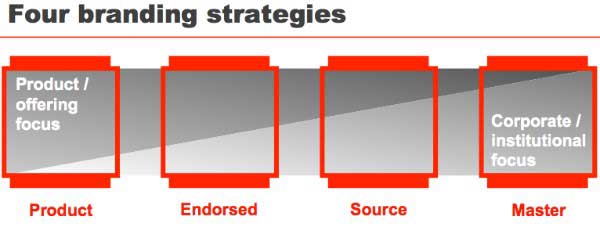Know who you are today––and who you want to become.
Think of your brand as a mosaic. In that mosaic, you can select and place most, but not all, of the tiles: You can control the communications you make, your offerings, and how your organization behaves––and, therefore, you can control the brand picture these tiles present.
But some of the tiles in your brand mosaic are placed by others––the media, bloggers, tweets, the conversations that happen outside your walls.
Because the brand picture assembled in the hearts and minds of your constituents is a mix of both what you can control and what you can't—but would certainly like to influence––it's important to develop a strong foundation for your brand.
Why? Because that foundation will help guide where others place tiles in your mosaic. A strong foundation is one that can inform a range of communications by you and others; it helps people to understand and value you in the ways you'd like them to.
And while much of your brand foundation may never be visible to the outside world, the stronger these underpinnings are––the more they evolve from your unique identity––the more your messages, visual system, and tactical communications will cohere and support your desired meaning and image.
And, as a result, the more likely it will be that those tiles placed in your mosaic by others will have positive context.
The Thinking to Inform Expression and Action
The components of your brand foundation (see diagram below) are all intangible: They're decisions, strategies, and points of view that define who you are––and aspire to be––and how you want to be understood and valued. And while those decisions and directions should be informed by research on your constituents, environment, and opportunities (see the articles "Gaining Insight..." and "Achieving Relevance..."), in the end they're driven by your leadership's vision.

From the bottom up, the components of your brand foundation:
Category
Do you fit into an existing category (you're a software developer or you're a commercial real estate office), or do you have to invent one?
If you're in one, then your job is to prove you're the most worthy of attention and participation.
If you're not (think of the Sony Walkman before there were any portable, user-programmable, personal music delivery systems), then you have your work cut out—to either establish a new category (and then be the leader of it) or build your brand without the reference point that an existing mental model provides.
Model
How are you structured to do business? If you're a Web-based, language-translation engine, what is your business model? Is everything free to viewers and ads supply the revenue? Do you give away entry-level services and sell subscriptions for more sophisticated needs?
Making your model transparent means people don't have to spend time figuring it out––and can therefore engage with you more productively.
Areas of endeavor
What are the different lines of work you're engaged in? Few organizations do just one thing, but that can often make it hard for people to understand what you're about––either because the range of what you do is hard to get a handle on (so you look diffuse), or because a person associates you with only one of the bits you're about (so they see twigs, or a tree, but not the forest).
Either way, you're not known for what you want to be known for and you don't get credit for your hard work.
Come up with 3-5 focus areas that people can remember: If you're an arts organization with 17 programs, maybe they can be grouped into "performing arts," "visual arts," and "community engagement." If you're a management consulting firm with wide expertise, perhaps you can group services by what keeps your customers awake at night: technology integration, human resource optimization, etc.
Vision and mission
How do you see the future? How are you organized to bring about that vision? It's important to get these two foundational components nailed, not because they may ever be touted externally (usually not), but because getting agreement around them informs how you talk, write, design, and behave.
Brand strategy
How are your different offerings or businesses connected (or not) among themselves––and to your master brand?
Different brand strategies provide purposeful ways to bring what you do either closer together, gathered under a "master-branded" umbrella (think HP or IBM)––or deliberately separated, obscuring the link to the master brand through "product branding" (think of all the candy bars Mars produces, but allegiance and promotion is all at the level of M&Ms and Snickers).
These two strategies mark either end of a brand strategy continuum (see chart, below). In between are "source branding," where both the brand of the offering and the parent brand are invested in and brought forward within a common visual system (think Pepperidge Farm and Milanos or Apple and iPhone), and "endorsed branding," where product brands are connected to a lesser degree by an "endorsing" brand (think of the Nabisco triangle on Oreos and Fig Newtons or the Kellogg's imprimatur on cereal boxes).
Strategies can be used separately or together to achieve different goals. What's important is that you think about the desired connection/distance you want among offerings and businesses, and set your strategies with intent. (The brand distance that Toyota has placed between itself and Lexus has served Lexus well in recent months; sales of the latter have actually increased.)

Personality
Are you friendly and approachable, or slightly chilly and out-of-reach? (Think Gap and Prada.) Are you blazingly innovative, or is there a level of risk associated with innovative that would scare off prospects who are looking for a reassuring, bankable partner?
Article Series:
Branding in the Age of Social
Your customers—your communities—have new expectations. They want to (actually!) interact with your organization. They want to know what they want to know—when they want to know it. And, as always, they want to know, and feel, how your organization and its brand align with their personal brands and values.
Achieving that alignment has always been critical to effective brand-building. But it's not enough to design a new logo, snappy tagline, brochures, and website (it never was).
Brand-building in this social age—social branding—goes beyond social, or even digital, media. It's about deliberately aligning your and your constituents' expectations and values, not just in communications but at the core of how your organization sees and organizes itself, how it behaves, and how it delivers on its core purpose.
In this article series, we'll outline the seven pieces of the social branding process and how each step can work hard to maximize the connections between not only you and your customers but also the connections between your customers and their trusted friends and peers (in other words, to maximize "social capital").
The series culminates with an online seminar in April, "7 Steps to Take Your Brand Social... and Still Be in Control," where you'll learn how to evaluate and develop your strategy for building your social brand.
—Tamsen
McMahon
Director of Strategic Initiatives
Sametz Blackstone Associates
Figuring out the personality traits you want your brand to convey is important––and every brochure, package, tweet, and automated phone menu can help you to build that personality.
Position
Looking across your competitive landscape, what acreage can you stake out as your own? What is your differentiating value proposition?
Clearly articulating your position helps customers and prospects evaluate you in the context you desire. Audi and Volkswagen may share a lot under different sheet metal, but they're positioned in completely different markets––against different sets of competitors.
Internal Alignment Before External Engagement
Ideally, you want to think about your brand foundation in two timeframes: now and a bit further out. You want to know where you are now, but also where you'd like to be––being mindful that the gap between current and aspirational is not so wide as to be neither credible nor attainable.
With your brand foundation agreed upon, you're in a great position to add to what you know about your constituents to build a messaging platform, visual system, and the specific communications needed to connect with your consistencies––to move them to build your brand mosaic in their heads, and contribute to it through their conversations and interactions.
While perhaps obvious, it's critical to achieve internal clarity before attempting external engagement. But the really good news is that the process of investigating and making these foundational decisions around your current and desired identity can also be an extremely useful organizational exercise––one that helps to bring up different ideas and directions and then, ideally, fosters renewed enthusiasm in a shared enterprise.




